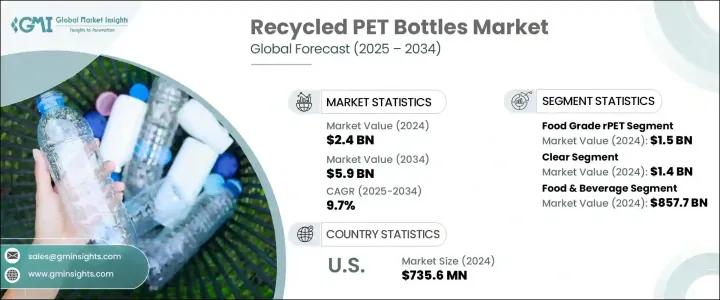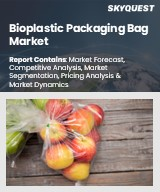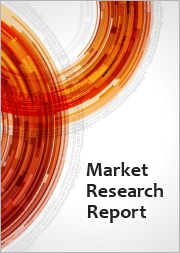
|
시장보고서
상품코드
1721416
재생 페트병 시장 : 기회 및 성장 촉진요인, 산업 동향 분석 및 예측(2025-2034년)Recycled PET Bottles Market Opportunity, Growth Drivers, Industry Trend Analysis, and Forecast 2025 - 2034 |
||||||
세계의 재생 페트병 시장은 2024년 24억 달러로 평가되었고, 2034년에는 59억 달러에 이를 것으로 예측되며, CAGR 9.7%로 성장할 전망입니다. 지속가능성이 산업 전반의 핵심 화두로 떠오르면서 친환경적이고 재활용 가능한 포장재에 대한 수요가 가속화되고 있습니다. 특히 기업들이 버진 플라스틱에 대한 의존도를 줄이기 위해 폐쇄 루프 시스템으로 전환하면서 재생 페트(rPET)병이 상당한 탄력을 받고 있습니다. 환경 문제에 대한 인식이 높아지고, 플라스틱 폐기물에 대한 우려가 커지고, 전 세계적으로 엄격한 규제가 시행되면서 제조업체들은 친환경 포장재를 채택하고 있습니다. 소비자들 역시 지속 가능한 포장재에 담긴 제품을 적극적으로 찾고 있으며, 재활용을 실천하는 브랜드는 경쟁 우위를 확보할 수 있습니다. 식음료, 퍼스널 케어, 가정용품과 같은 산업은 진화하는 시장 역학 관계와 환경을 생각하는 소비자 행동에 대응하면서 이러한 변화의 주요 원인으로 떠오르고 있습니다.

재생 페트병은 식품 등급과 비식품 등급으로 분류됩니다. 식품 등급 부문은 2024년 15억 달러의 가치로 시장을 주도했습니다. 이 부문은 식음료 기업들이 탄소 발자국을 줄이기 위해 노력함에 따라 계속해서 성장하고 있습니다. 안전 기준을 준수하는 고품질 식품 등급 rPET의 출시로 인해 주요 업체들은 지속 가능한 포장을 제품 라인에 더 쉽게 통합할 수 있게 되었습니다. 한편, 비식품 등급 rPET는 특히 시각적 매력이나 기능을 손상시키지 않으면서 재활용 가능한 포장재로 전환하고 있는 퍼스널 케어 산업에서 그 입지를 넓혀가고 있습니다.
| 시장 범위 | |
|---|---|
| 시작 연도 | 2024년 |
| 예측 연도 | 2025-2034년 |
| 시작 금액 | 24억 달러 |
| 예측 금액 | 59억 달러 |
| CAGR | 9.7% |
병 유형별로는 투명 재생 페트병이 2024년 14억 달러로 가장 큰 시장 점유율을 차지했습니다. 이 병은 투명도가 높고 재활용이 용이해 물, 탄산음료, 주스 포장에 선호도가 높으며, 일반 PET와 매우 유사합니다. 제조업체는 폐쇄 루프 재활용 시스템에 대한 적응성과 소비자 친화적 인 미학으로 인해 투명 rPET를 선호합니다. 유제품, 샴푸, 즉석식품의 소비가 증가함에 따라 제품 가시성과 환경적 가치를 모두 제공하는 투명 rPET 병에 대한 수요도 증가하고 있습니다.
미국의 재생 페트병 시장은 2024년 7억 3,560만 달러 규모에 달할 것으로 예상됩니다. 이러한 지역적 성장은 플라스틱 폐기물을 최소화하기 위한 강력한 규제 조치와 주요 기업들이 순환 포장 전략으로 전환하는 추세에 힘입어 더욱 가속화되고 있습니다.
Alpek SAB de CV, Amcor, Resilux NV와 같은 업계 선두는 생산 능력을 확장하고 재활용 기술을 강화하며 환경 단체와 협력하여 지속가능성 목표를 달성하는 동시에 글로벌 시장 입지를 강화해 나가고 있습니다.
목차
제1장 조사 방법과 범위
제2장 주요 요약
제3장 업계 인사이트
- 생태계 분석
- 업계에 미치는 영향 요인
- 성장 촉진요인
- 규제의무와 지속가능성 목표
- 친환경 포장에 대한 소비자의 선호도 증가
- 퍼스널케어 및 화장품 부문의 확대
- 성장하는 음료 및 식품 포장 업계
- 재활용 기술의 발전
- 업계의 잠재적 위험 및 과제
- 비효율적인 재활용 인프라
- rPET의 제한된 가용성 및 높은 비용
- 성장 촉진요인
- 성장 가능성 분석
- 규제 상황
- 기술의 상황
- 장래 시장 동향
- 갭 분석
- Porter's Five Forces 분석
- PESTEL 분석
제4장 경쟁 구도
- 소개
- 기업의 시장 점유율 분석
- 주요 시장 기업의 경쟁 분석
- 경쟁 포지셔닝 매트릭스
- 전략 대시보드
제5장 시장 추계 및 예측 : 학년별(2021-2034년)
- 주요 동향
- 식품 등급 rPET
- 비식품 등급 rPET
제6장 시장추계 및 예측 : 유형별(2021-2034년)
- 주요 동향
- 투명
- 착색
제7장 시장 추계 및 예측 : 최종 이용 산업별(2021-2034년)
- 주요 동향
- 식음료
- 의약품
- 퍼스널케어 및 화장품
- 기타
제8장 시장추계 및 예측 : 지역별(2021-2034년)
- 주요 동향
- 북미
- 미국
- 캐나다
- 유럽
- 독일
- 영국
- 프랑스
- 스페인
- 이탈리아
- 네덜란드
- 아시아태평양
- 중국
- 인도
- 일본
- 호주
- 한국
- 라틴아메리카
- 브라질
- 멕시코
- 아르헨티나
- 중동 및 아프리카
- 사우디아라비아
- 남아프리카
- 아랍에미리트(UAE)
제9장 기업 프로파일
- Alpek SAB de CV
- ALPLA Werke Alwin Lehner GmbH &Co KG
- Verdeco Recycling, Inc.
- Amcor
- Berry Global Group, Inc
- Sidel Group
- Resilux NV
- Graham Packaging
- Taiwan Hon Chuan
- Phoenix Technologies
The Global Recycled PET Bottles Market was valued at USD 2.4 billion in 2024 and is estimated to grow at a CAGR of 9.7% to reach USD 5.9 billion by 2034. As sustainability becomes a core focus across industries, the demand for eco-friendly and recyclable packaging materials is accelerating. Recycled PET (rPET) bottles are gaining significant momentum, especially as companies shift toward closed-loop systems to reduce dependency on virgin plastic. The increased awareness around environmental issues, rising plastic waste concerns, and stringent global regulations are pushing manufacturers to adopt greener packaging alternatives. Consumers, too, are actively seeking out products housed in sustainable packaging, giving brands a competitive edge when they commit to recycling practices. Industries such as food and beverage, personal care, and household products are emerging as major contributors to this transition as they respond to evolving market dynamics and eco-conscious consumer behavior. Technological advancements in recycling processes have further boosted the quality and safety of rPET materials, opening up new avenues for application and scalability in the packaging sector.

Recycled PET bottles are classified into food-grade and non-food-grade categories. The food-grade segment led the market with a value of USD 1.5 billion in 2024. This segment continues to gain ground as food and beverage companies commit to cutting their carbon footprints. The availability of high-quality food-grade rPET that complies with safety standards has made it easier for major players to incorporate sustainable packaging into their product lines. On the other hand, non-food-grade rPET is also expanding its footprint, particularly in the personal care industry, where brands are shifting to recyclable packaging without compromising visual appeal or functionality.
| Market Scope | |
|---|---|
| Start Year | 2024 |
| Forecast Year | 2025-2034 |
| Start Value | $2.4 Billion |
| Forecast Value | $5.9 Billion |
| CAGR | 9.7% |
By bottle type, clear recycled PET bottles commanded the largest market share, reaching USD 1.4 billion in 2024. These bottles closely resemble virgin PET and are highly favored for water, carbonated beverages, and juice packaging due to their clarity and ease of recycling. Manufacturers prefer clear rPET for its adaptability to closed-loop recycling systems and its consumer-friendly aesthetic. The rising consumption of dairy products, shampoos, and ready-to-eat meals has also contributed to the growing demand for clear rPET bottles, offering both product visibility and environmental value.
The United States Recycled PET Bottles Market accounted for USD 735.6 million in 2024. This regional growth is fueled by strong regulatory measures aimed at minimizing plastic waste and an increasing shift among leading companies toward circular packaging strategies.
Industry leaders like Alpek S.A.B. de C.V., Amcor, and Resilux NV are scaling production capabilities, enhancing recycling technologies, and partnering with environmental bodies to meet sustainability goals while strengthening their global market presence.
Table of Contents
Chapter 1 Methodology and Scope
- 1.1 Market scope and definitions
- 1.2 Research design
- 1.2.1 Research approach
- 1.2.2 Data collection methods
- 1.3 Base estimates and calculations
- 1.3.1 Base year calculation
- 1.3.2 Key trends for market estimation
- 1.4 Forecast model
- 1.5 Primary research and validation
- 1.5.1 Primary sources
- 1.5.2 Data mining sources
Chapter 2 Executive Summary
- 2.1 Industry 3600 synopsis
Chapter 3 Industry Insights
- 3.1 Industry ecosystem analysis
- 3.2 Industry impact forces
- 3.2.1 Growth drivers
- 3.2.1.1 Regulatory mandates and sustainability goals
- 3.2.1.2 Growing consumer preference for eco-friendly packaging
- 3.2.1.3 Expansion of the personal care & cosmetics sector
- 3.2.1.4 Growing beverage & food packaging industry
- 3.2.1.5 Advancements in recycling technologies
- 3.2.2 Industry pitfalls and challenges
- 3.2.2.1 Inefficient recycling infrastructure
- 3.2.2.2 Limited availability & high cost of rPET
- 3.2.1 Growth drivers
- 3.3 Growth potential analysis
- 3.4 Regulatory landscape
- 3.5 Technology landscape
- 3.6 Future market trends
- 3.7 Gap analysis
- 3.8 Porter’s analysis
- 3.9 PESTEL analysis
Chapter 4 Competitive Landscape, 2024
- 4.1 Introduction
- 4.2 Company market share analysis
- 4.3 Competitive analysis of major market players
- 4.4 Competitive positioning matrix
- 4.5 Strategy dashboard
Chapter 5 Market Estimates and Forecast, By Grade, 2021 - 2034 (USD Million & Million Units)
- 5.1 Key trends
- 5.2 Food-Grade rPET
- 5.3 Non-Food-Grade rPET
Chapter 6 Market Estimates and Forecast, By Type, 2021 - 2034 (USD Million & Million Units)
- 6.1 Key trends
- 6.2 Clear
- 6.3 Colored
Chapter 7 Market Estimates and Forecast, By End Use Industry, 2021 - 2034 (USD Million & Million Units)
- 7.1 Key trends
- 7.2 Food & beverage
- 7.3 Pharmaceuticals
- 7.4 Personal care & cosmetics
- 7.5 Others
Chapter 8 Market Estimates and Forecast, By Region, 2021 - 2034 (USD Million & Million Units)
- 8.1 Key trends
- 8.2 North America
- 8.2.1 U.S.
- 8.2.2 Canada
- 8.3 Europe
- 8.3.1 Germany
- 8.3.2 UK
- 8.3.3 France
- 8.3.4 Spain
- 8.3.5 Italy
- 8.3.6 Netherlands
- 8.4 Asia Pacific
- 8.4.1 China
- 8.4.2 India
- 8.4.3 Japan
- 8.4.4 Australia
- 8.4.5 South Korea
- 8.5 Latin America
- 8.5.1 Brazil
- 8.5.2 Mexico
- 8.5.3 Argentina
- 8.6 Middle East and Africa
- 8.6.1 Saudi Arabia
- 8.6.2 South Africa
- 8.6.3 UAE
Chapter 9 Company Profiles
- 9.1 Alpek S.A.B. de C.V.
- 9.2 ALPLA Werke Alwin Lehner GmbH & Co KG
- 9.3 Verdeco Recycling, Inc.
- 9.4 Amcor
- 9.5 Berry Global Group, Inc
- 9.6 Sidel Group
- 9.7 Resilux NV
- 9.8 Graham Packaging
- 9.9 Taiwan Hon Chuan
- 9.10 Phoenix Technologies



















